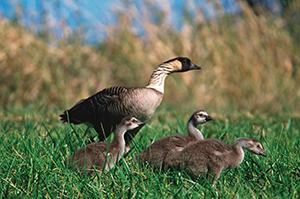Hawaiian Nene
The official bird of Hawaii, the nene is found in the wild on the islands of Oahu, Maui, Kauai, Molokai and Hawaii.

An iconic species, the Hawaiian nene (Hawaiian goose) are adaptable waterfowl that have endured extreme population declines over the last century. In the 1950s, the population plummeted to roughly 30 birds in the wild. Sustained efforts have brought the population back to an estimated 1,400.
Found from sea-level to 8,000 feet in a range of habitats, private lands are essential to the species’ recovery. Because of past and ongoing recovery efforts, the nene is being considered for down-listing from its current endangered status.
The Natural Resources Conservation Service (NRCS) is working with The Nene Recovery Action Group (NRAG) to identify recovery actions, habitat and maintain multiple self-sustaining populations through NRCS’ Working Lands for Wildlife (WLFW) model.
NRCS and NRAG will work with key private landowners and agricultural producers to determine quality of habitat, management considerations and to develop regulatory assurances with the U.S. Fish and Wildlife Service (FWS).
NRCS offers technical and financial assistance to help agricultural producers to support recovery of the nene and voluntarily improve habitat for this species. This assistance helps producers plan and implement a variety of conservation activities or practices that benefit an entire ecosystem.
Technical assistance is free to producers. The agency’s staff of experts and conservation partners work side-by-side with producers to develop a conservation plan. Each plan focuses on the restoration of the habitat range and is tailored to the landowner’s property. These plans provide a roadmap for how to use a system of conservation practices to meet natural resource and production goals.
Financial assistance helps producers pay for the adoption of conservation systems that improve the health of wetland ecosystems. Common conservation practices include brush management, site preparation and upland wildlife habitat management.
This project is part of the Working Lands for Wildlife (WLFW) partnership, a collaborative approach to conserve habitat on working lands. WLFW provides technical and financial assistance through the Environmental Quality Incentives Program, Agricultural Conservation Easement Program and Conservation Innovation Grants, all conservation programs of the Farm Bill, the largest funding source for conservation on private lands.
Habitat restored for the Hawaiian nene benefits many other species including the Hawaiian hoary bat, migratory water fowl including the Northern pintail and other endangered Hawaiian water birds.

